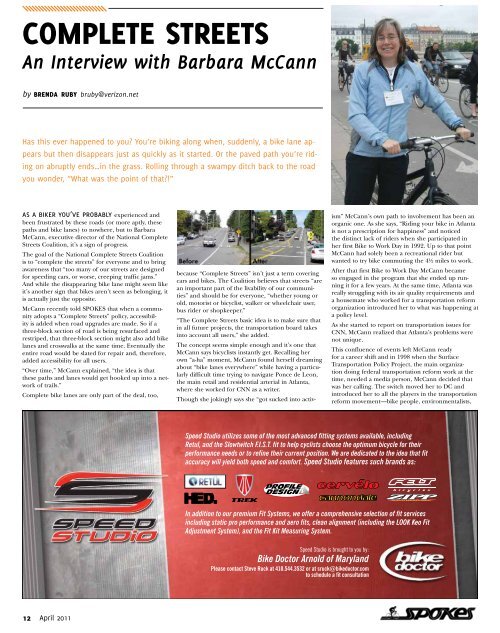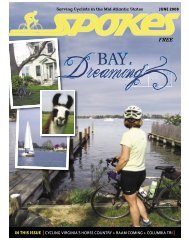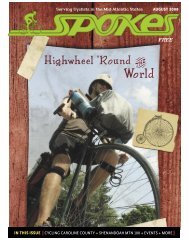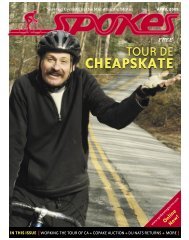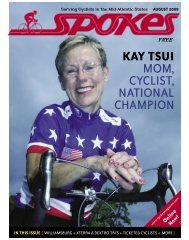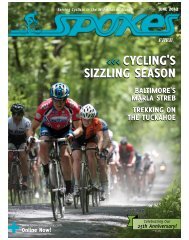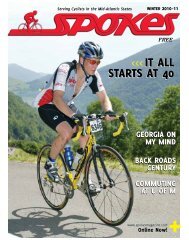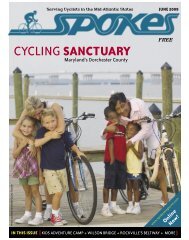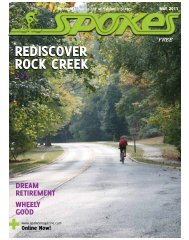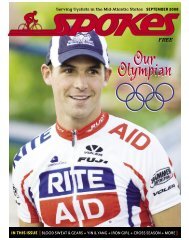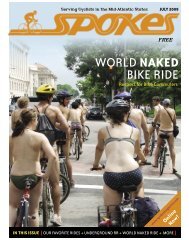April 2011 - Spokes Magazine
April 2011 - Spokes Magazine
April 2011 - Spokes Magazine
You also want an ePaper? Increase the reach of your titles
YUMPU automatically turns print PDFs into web optimized ePapers that Google loves.
Complete Streets<br />
An Interview with Barbara McCann<br />
by brenda ruby bruby@verizon.net<br />
Has this ever happened to you? You’re biking along when, suddenly, a bike lane appears<br />
but then disappears just as quickly as it started. Or the paved path you’re riding<br />
on abruptly ends…in the grass. Rolling through a swampy ditch back to the road<br />
you wonder, “What was the point of that?!”<br />
as a biker you’ve probably experienced and<br />
been frustrated by these roads (or more aptly, these<br />
paths and bike lanes) to nowhere, but to Barbara<br />
McCann, executive director of the National Complete<br />
Streets Coalition, it’s a sign of progress.<br />
The goal of the National Complete Streets Coalition<br />
is to “complete the streets” for everyone and to bring<br />
awareness that “too many of our streets are designed<br />
for speeding cars, or worse, creeping traffic jams.”<br />
And while the disappearing bike lane might seem like<br />
it’s another sign that bikes aren’t seen as belonging, it<br />
is actually just the opposite.<br />
McCann recently told SPOKES that when a community<br />
adopts a “Complete Streets” policy, accessibility<br />
is added when road upgrades are made. So if a<br />
three-block section of road is being resurfaced and<br />
restriped, that three-block section might also add bike<br />
lanes and crosswalks at the same time. Eventually the<br />
entire road would be slated for repair and, therefore,<br />
added accessibility for all users.<br />
“Over time,” McCann explained, “the idea is that<br />
these paths and lanes would get hooked up into a network<br />
of trails.”<br />
Complete bike lanes are only part of the deal, too,<br />
because “Complete Streets” isn’t just a term covering<br />
cars and bikes. The Coalition believes that streets “are<br />
an important part of the livability of our communities”<br />
and should be for everyone, “whether young or<br />
old, motorist or bicyclist, walker or wheelchair user,<br />
bus rider or shopkeeper.”<br />
“The Complete Streets basic idea is to make sure that<br />
in all future projects, the transportation board takes<br />
into account all users,” she added.<br />
The concept seems simple enough and it’s one that<br />
McCann says bicyclists instantly get. Recalling her<br />
own “a-ha” moment, McCann found herself dreaming<br />
about “bike lanes everywhere” while having a particularly<br />
difficult time trying to navigate Ponce de Leon,<br />
the main retail and residential arterial in Atlanta,<br />
where she worked for CNN as a writer.<br />
Though she jokingly says she “got sucked into activism”<br />
McCann’s own path to involvement has been an<br />
organic one. As she says, “Riding your bike in Atlanta<br />
is not a prescription for happiness” and noticed<br />
the distinct lack of riders when she participated in<br />
her first Bike to Work Day in 1992. Up to that point<br />
McCann had solely been a recreational rider but<br />
wanted to try bike commuting the 4½ miles to work.<br />
After that first Bike to Work Day McCann became<br />
so engaged in the program that she ended up running<br />
it for a few years. At the same time, Atlanta was<br />
really struggling with its air quality requirements and<br />
a housemate who worked for a transportation reform<br />
organization introduced her to what was happening at<br />
a policy level.<br />
As she started to report on transportation issues for<br />
CNN, McCann realized that Atlanta’s problems were<br />
not unique.<br />
This confluence of events left McCann ready<br />
for a career shift and in 1998 when the Surface<br />
Transportation Policy Project, the main organization<br />
doing federal transportation reform work at the<br />
time, needed a media person, McCann decided that<br />
was her calling. The switch moved her to DC and<br />
introduced her to all the players in the transportation<br />
reform movement—bike people, environmentalists,<br />
Speed Studio utilizes some of the most advanced fitting systems available, including<br />
Retul, and the Slowtwitch F.I.S.T. fit to help cyclists choose the optimum bicycle for their<br />
performance needs or to refine their current position. We are dedicated to the idea that fit<br />
accuracy will yield both speed and comfort. Speed Studio features such brands as:<br />
In addition to our premium Fit Systems, we offer a comprehensive selection of fit services<br />
including static pro performance and aero fits, clean alignment (including the LOOK Keo Fit<br />
Adjustment System), and the Fit Kit Measuring System.<br />
Speed Studio is brought to you by:<br />
Bike Doctor Arnold of Maryland<br />
Please contact Steve Ruck at 410.544.3532 or at sruck@bikedoctor.com<br />
to schedule a fit consultation<br />
12 <strong>April</strong> <strong>2011</strong>


